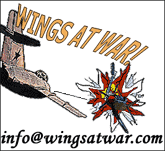Aircraft Of The Korean War
As with the majority of the conflicts covered by Wings At War the aircraft involved in Korea were designed to fight a battle that in the end they did not fight. Immediately after WW2 the main threat was seen as enemy nuclear bombers, so the greatest effort and resources went into building ever larger bombers. Priority number two was a fighter to bring down those bombers. Ground attack and traditional battlefield air superiority would have to make do. The Korean War however, was a throwback and many of the aircraft, with the notable exception of the F-86 and MiG-15, were found wanting either due to obsolescence or through being asked to perform missions for which they were not designed.
The following lists the main aircraft types that participated in the Korean War. The Vapour Trails catalogue number is in blue.
THE MAIN PROTAGONISTS
Mikoyan-Gurevich MiG-15
With the help of German wartime technology
and a couple of Rolls Royce jet engines naively gifted to the Russians by
the British Labour government, the Soviets started design of a bomber destroyer
in 1946. High performance and simplicity were the aim; quantity
was considered more important that quality. However, the final product
turned out to be an outstanding aircraft in all aspects. Fast - able to fly at very near the speed of sound - and armed with
one 37mm and two 23mm cannons it was a superb dogfighter as well
as a deadly bomber destroyer.
As a consequence of being lighter than the F-86 but with around the same thrust the MiG-15 had a higher ceiling than its main adversary. This meant the MiGs could cruise above UN fighters with impunity and choose when to dive into the attack, the optimum time being when the enemy were approaching the point where expenditure of fuel meant they were ready to head for home. This tactic always gave the initiative in a straight clash to the MiG. However, this meant that UN bombers would be free to drop their load unless the MiGs risked coming down to their level, thus allowing the F-86s to join in.
Apart from the Honchos, most
Communist pilots were weary of mixing it with Sabres. The favoured
tactic was a high speed dive firing pass followed by a rapid climb
back up to safety. Though very manoeuverable the MiG did suffer
from the tendency to drop a wing and enter a spin during very hard
turning and the lack of a G-suit meant blacking out in a tight turn
was always a risk. The Russians supplied the Chinese with 4,000
MiG-15s, half of which were lost to various causes during the war.
ISA
706
North American F-86 Sabre
At first, a mixture of WW2 vintage
piston fighters and early straight-wing jets had proved more than
sufficient to take on the Communist piston-engine fighters used
by the North Koreans. The more advanced swept-wing F-86 Sabre was
kept back to protect the American homeland from incursion by Soviet
atom-bomb wielding bombers. Once China joined the fray and introduced
the MiG-15 the Americans were forced to rush into combat the F-86
equipped 4th and 5th Interceptor Wings. Each Wing had a total of
around 75 planes, though at any one time up to a third could be
undergoing maintenance in Japan.
The F-86 was the first US fighter to exploit the same German wartime research into swept-wing aerodynamics that the Russians used on the MiG-15. At the time it was the fastest and most advanced fighter in the West, as quick as the MiG and around 100 mph faster than any other jet. As with all contemporary USAF jets it was only armed with machineguns, six nose-mounted 0.5" calibre weapons. The USAF preferred the faster rate-of-fire of the machinegun over the cannon, along with the increased number of rounds that could be carried; about fifteen seconds worth as opposed to half this for the MiG-15. This gave a greater chance of scoring a hit than cannon but much less destructive power from each hit, especially on the robust MiG-15. A single strike from a 23mm explosive cannon shell could easily destroy an aircraft. It could take a dozen or more machinegun bullets to achieve the same effect.
Many RAF
and Canadian pilots had postings to USAF F-86 units and the South
African No. 2 Squadron eventually swapped their Mustangs for Sabres.
The F-86 and MiG-15 were broadly similar in performance though the
early mark MiGs were considered better than the early Sabres. The
deciding factor, as always, was the skill, experience and above
all aggressive determination of the pilot.
ISA 806
OTHER JETS
Lockheed F-80 Shooting Star
The Shooting Star was the first
effective jet-powered fighter in American service and the main US
fighter in the Far East at the start of the war, though quickly relegated to ground
attack duties. Its main claim to fame is that an F-80 scored the
World's first jet-jet victory when Russell J Brown's aggressive
counter-attack caused a MiG-15 pilot to take the wrong option of
diving rather than climbing away. Though five of his six 0.5"
machineguns jammed enough rounds hit home and caused the MiG to
crash in flames. Taking on piston-engine planes was a safer proposition
but it was found that the F-80's much higher speed and thirsty
engine put it at a disadvantage with the highly manoeuverable Yaks.
F-80 pilots claimed seventeen enemy kills.
ISA801
Republic F-84 Thunderjet
Used mainly to escort B-29 bombers
and for ground attack, the F-84 had originally been designed along
conservative lines in case the much more advanced F-86 prove to
be a failure. The performance of the Thunderjet was not significantly
better than the F-80 it was intended to replace. Ten enemy aircraft
fell to the F-84's six 0.5" MGs.
ISA804
Lockheed F-94 Starfire
Developed from the F-80 as a night
fighter, the extra weight of a second crewman and radar not only
degraded its performance but also limited armament to four 0.5"
MGs.
The F-94 was involved in a bizarre aerial duel when it
took on North Korean Po-2 biplane trainers flying night-time nuisance
raids. Dating from 1928 and with a top speed under 100 mph, the
biplanes still succeeded in dropping bomblets on several parked-up
F-86s and Australian Meteors. In its first attempt at halting this
affront an F-94 got on the tail of a Po-2, lowered flaps and wheels,
throttled right back and shot down the biplane with a hail of MG
bullets. Unfortunately the jet stalled and crashed killing both
crewmen. The second time an F-94 got behind a Po-2 it kept its speed
up to avoid stalling, but instead collided with the enemy destroying
both aircraft.
ISA809
McDonnell F2H Banshee
The versatile 'Banjo' was the second
jet type to see service aboard US carriers. Both the Navy and Marines
used the Banshee as a day and nightfighter and for reconnaissance.
Like the F9F however, ground attack capability was limited by short
range and small bomb load. The Navy preferred cannon to machineguns
and the Banshee was armed with four 20mm cannon.
ISA820
Douglas F3D Skyknight
Though armed with only two 20mm cannons
the large two-seat F3D, nicknamed 'Willie
The Whale', was the most successful
nightfighter in Korea, achieving the first ever night-time jet-jet
kill (the victim identified as a Yak-15 but more likely a MiG-15).
By the end of the war twenty-four land-based Skyknights were being
used by the Marines to escort B-29 night raids.
ISA823
Grumman F9F Panther
The main carrier jet, over 700 seeing action in Korea.
The F9F proved to be an effective if unexceptional aircraft. Its
swept-wing derivative the F9F-8 Cougar just missed seeing action
in Korea. The Panther was armed with the standard Navy fit of four
20mm cannons.
ISA829
Gloster Meteor
The only British designed jet used
in Korea, the by then venerable 'Meatbox' replaced Australian 77 Squadron's
Mustangs. Twin-engined, straight-winged and armed with four 20mm
cannons, it was not long before the Australians found themselves
completely out-classed by the faster MiG-15. After a brief effort
as an interceptor it was soon relegated to the role of fighter-bomber.
In its most memorable clash over MiG Alley, twelve Meteors mixed
it with around 40 MiGs on 1st December 1951. Two MiGs were claimed
but three Meteors were destroyed.
ISA80a
Yakolev Yak-15
Playing a very minor role in Korea, the Yak-15 was
the first Soviet jet, created by the simple expedient of replacing
a Yak fighter's piston engine with a wartime German jet.
use ISA701
PISTON-ENGINE PLANES
North American F-51 Mustang
Undoubtedly one of the best fighters
of WW2 and near the apogee of performance levels for a piston-engine
fighter, the Mustang soldiered on throughout the 1950s. Mainly used
for ground attack, F-51 pilots did manage to claim a dozen enemy
piston-engine aircraft destroyed. Like USAF jets, the F-51 was armed
with six 0.5" MGs.
ISA283b & ISA283c
North American F-82 'Twin Mustang'
The concept behind this somewhat odd
combination of two Mustangs joined by a common wing was to divide
the flying time for very long range escorts between two pilots.
However, the war in the Pacific was over before the F-82 entered
service and so the second seater was more
sensibly converted to a radar operator. Three squadrons were already
based in Japan in 1950 and as they were the only US fighter with
sufficient range to operate over Korea they saw plenty of action
at the start of the war.
ISA802a
Vought F-4U Corsair
Flying from both land bases and carriers the Corsair
was used as a fighter-bomber to support ground troops, and as a
nightfighter where it provided the navy with its only non-F-86 ace.
Armed with four 20mm cannon.
ISA261a and ISA 261b
F7F Tigercat
Lightweight for a two-seat twin-engine nightfighter,
but with tremendous fire power. Four 20mm and four 0.5" MGs
were used to good effect by the US Marines to ward off Communist
night nuisance raids.
ISA827
Douglas B-26 Invader
Not to be confused with the B-26 Marauder
of the 1940s, the Invader was designated A-26 during WW2. Used as
a medium bomber and ground attack plane in Korea. The Invader bristled
with machineguns being armed with six forward firing fixed 0.5"
MGs and two twin 0.5" MG turrets.
ISA294
Boeing B-29 Superfortress
At any one time during the Korean
War three Bomb Groups were flying strategic bomber missions out
of Japan. In a total of 21,000 sorties, B-29s dropped more tons
of bombs on Korea than they unloaded on Japan during WW2. At first
they were used in a tactical role to try and halt the Communist
onslaught before switching to a more conventional strategic role.
As in the war against North Vietnam in the following decade, the
Americans found their heavy bombers in Korea proved far less effective
than they had been against the much more industrialised Germany
and Japan. Targets were few and spread out, and damage could be
repaired quickly by thousands of impressed labourers.
On 23rd October 1951 a large gaggle of
MiG-15s attacked a force of eight B-29s over MiG Alley. Even though
the bombers were protected by both F-84s and F-86s, two B-29s were
shot down and five badly damaged. Daylight raids were no longer an
option and the B-29 switched to night raids. B-29 gunners
used their five remote-controlled twin 0.5" turrets and tail
mounted 20mm cannon to shoot down 27 enemy planes, a total
only exceeded by the F-86. One Superfortress even become an ace,
Command Decision shooting down five MiG-15s.
ISA290
Douglas AD Skyraider
One of the greatest warplanes ever,
the design of the single-seat Skyraider dated from WW2 and it saw
action from post war right through to Vietnam more than 20 years later. With longer
range than navy jets the Skyraider was the main bomb carrier operated
by the US Navy. Able to drop up to 8,000 lbs of bombs, including
on one occasion the proverbial kitchen sink, with deadly accuracy.
Some of its main targets were communications choke-points such as
bridges, rail yards and tunnels. Manoeuverable and armed with four
20mm cannons the Skyraider could also hold its own in a dogfight.
ISA831 or ISA831b
Supermarine Seafire
A simple conversion of the incomparable
Spitfire, the Seafire proved too short ranged, difficult to land
on a carrier and not really robust enough to operate from flat tops.
After three months spent in the Yellow Sea HMS Triumph and its dozen
Spitfires were withdrawn to be replaced by carriers operating the
Sea Fury. Armament consisted of four 20mm cannons.
ISA601 & ISA601a
Hawker Sea Fury
Like the Seafire, the Sea Fury was
a navalised version of an RAF fighter and was also armed with four
20mm cannons. Better suited to carrier operations than the Seafire
it was a tough and effective fighter-bomber, for example HMS Glory's
two Sea Fury squadrons flew 4,834 missions for the loss of only
twenty-seven aircraft. Peter 'Hoagey' Carmichael flying from HMS
Ocean grabbed the first MiG-15 to be shot down by a piston-engine
fighter.
ISA602
and ISA602a
Fairey Firefly
Not blessed with the most butch of names the Fairey
Firefly was nonetheless one of the hardest worked aircraft in Korea
and it flew thousands of missions from both British and Australian
carriers. A two-seat fighter-bomber/attack plane armed with four
20mm cannon, it generally worked in tandem with the Sea Fury performing
reconnaissance as well as attack duties.
ISA52b
Yakovlev Fighters
37,000 Yak fighters were built during WW2. Progressive
improvements in performance meant that by the Yak-9 model the Soviet
designers had caught up with the West (though lightly armed by comparison
with one 23mm and two 12.7mm/0.5" machineguns). The Yak-3,
-7 and -9 served in Korea.
ISA369 for Yak-3 or -7 and ISA370 for Yak-9
Lavochkin Fighters
The La-5, -7, -9 and -11, also dating from WW2, were
powered by big rotary engines rather than the sleek inline engines
of the Yak series. This made them more suitable as fighter-bombers
(less susceptible to ground fire) and they carried a heavier armament
of three 23mm cannons.
ISA361
and ISA261a
Ilyushin Il-10 Shturmovik
A development of the heavily armoured
two-seat Il-2 tank buster of WW2 fame. The Shturmovik was a powerful ground attack plane, armed with bombs or rockets plus two
heavy cannons and a rear-mounted flexible MG. Its somewhat sedate
performance made it vulnerable to cannon-armed jets.
ISA371b & c
Tupolev Tu-2
Seeing action towards the end of WW2 the Tu-2 medium
bomber was an excellent machine for its time. The crew of four had
a defensive armament of two fixed 20mm cannons and three single-mounted
12.7mm flexible machineguns.
ISA380
Forward Air Controllers
UN FACs played an important role in Korea,
spotting the often fleeting glimpse of enemy troops and directing
fighter-bombers to the target. Chief among the light aircraft used
in this role were the little two-seat Stinson L-5 Sentinel and the
larger Texan T-6 trainer.
ISA825 for the L-5 and ISA810 for the T-6
Helicopters
A few 'whirlybirds' made the odd brief appearance
in WW2 but it was the UN's use of helicopters in Korea where it
really came of age. Along with 'MASH' style casualty evacuation,
one of the main roles was in search and rescue of downed aircrew.
The UN inventory included the Navy's Vought Sikorsky H-5/S-51 Dragonfly
and the USAF Sikorsky H-19/S-55 Chickasaw. Flying over enemy territory
in those early days was a dangerous business, even when accompanied
by the usual escort of an F-82 or F-80. One Dragonfly even fell
victim to a MiG-15.
Amongst the many successful rescue missions
was that of Jo McConnell. His Sabre was shot up by a MiG-15 over
MiG Alley and he managed to coax his flaming plane to the coast
and eject over the Yellow Sea. Within 20 minutes an H-19 had plucked
him from the choppy water. Had it not been for the fragile rickety
sanctity provided by the helicopter he would not have reached his
final tally of sixteen enemy kills.
ISA815 for the H-5 and ISA816 for the H-19
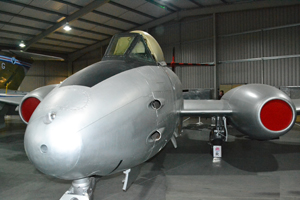 Gloster Meteor at the Jet Age Museum
Gloucester
Gloster Meteor at the Jet Age Museum
Gloucester
Click on the links below for more information
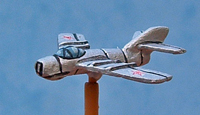
MiG-15
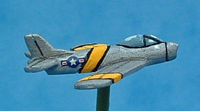
F-86 Sabre
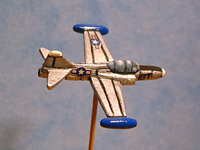
F-94 Starfire

Meteor
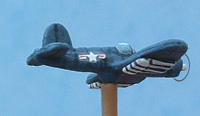
F-4U Corsair
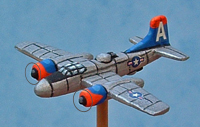
B-26 Invader
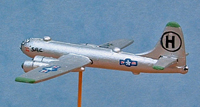
B-29 Superfortress

Sea Fury
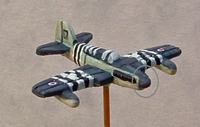
Firefly
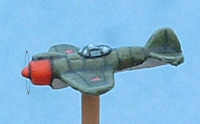
La-5
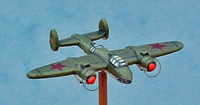
Tu-2
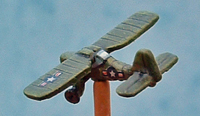
L-5 Sentinel
